ECO202 Macroeconomics Assignment: Analysis of Economic Concepts
VerifiedAdded on 2022/10/18
|8
|1621
|7
Homework Assignment
AI Summary
This economics assignment, completed for the ECO202 Macroeconomics course, addresses several key macroeconomic concepts. The assignment begins by analyzing the factors influencing the value of a currency and differentiates between real and nominal interest rates, emphasizing the relevance of the real rate. It then contrasts recessions and depressions, highlighting their defining characteristics and the factors influencing consumer behavior during economic downturns. The assignment also includes a supply and demand analysis of a van market, examining the effects of opening to trade and government tariffs. Finally, it explores different types of unemployment, providing an overview of frictional, structural, cyclical, and seasonal unemployment, and relating them to the economic conditions in Australia. The solution incorporates references using the Harvard style.
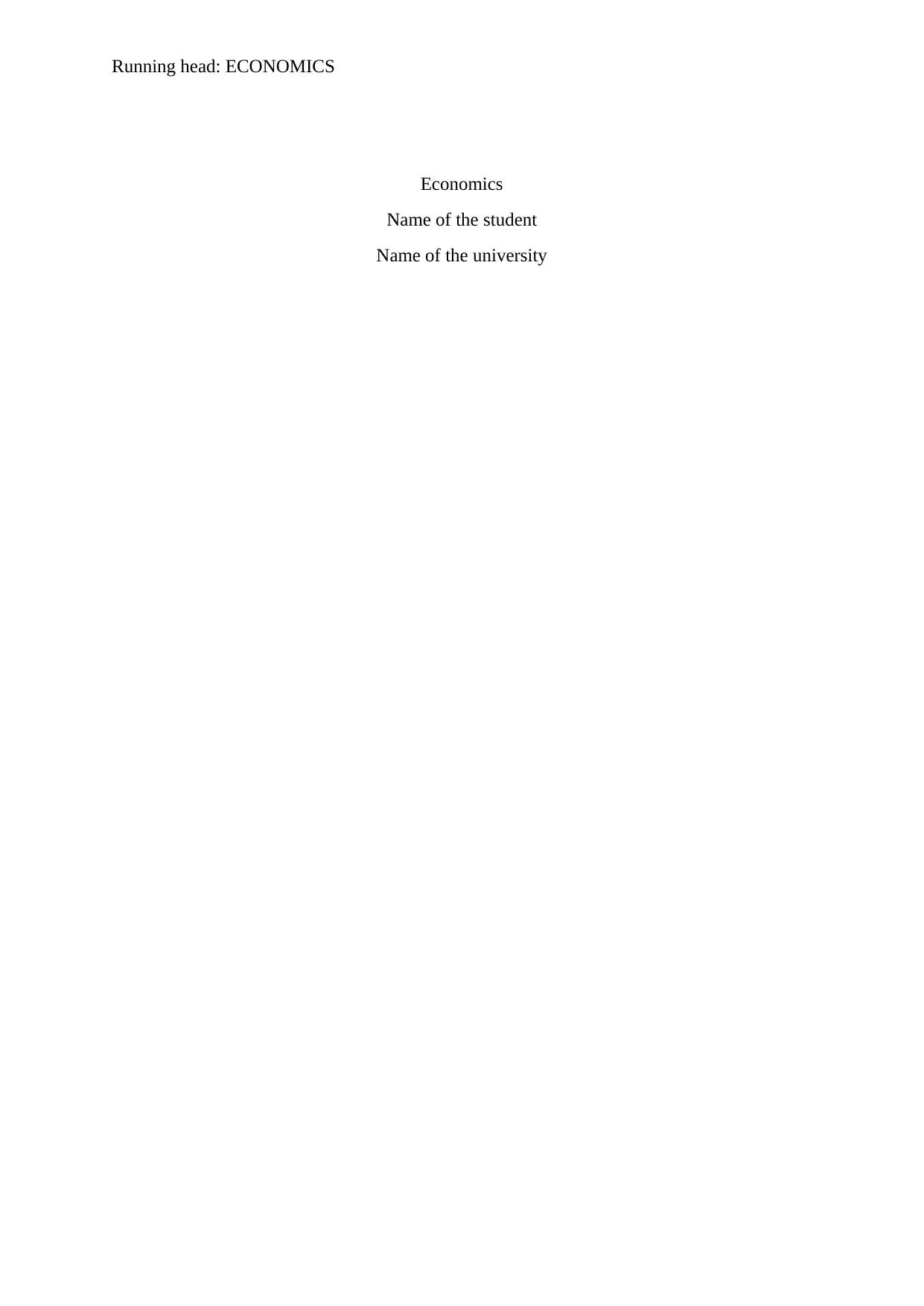
Running head: ECONOMICS
Economics
Name of the student
Name of the university
Economics
Name of the student
Name of the university
Paraphrase This Document
Need a fresh take? Get an instant paraphrase of this document with our AI Paraphraser
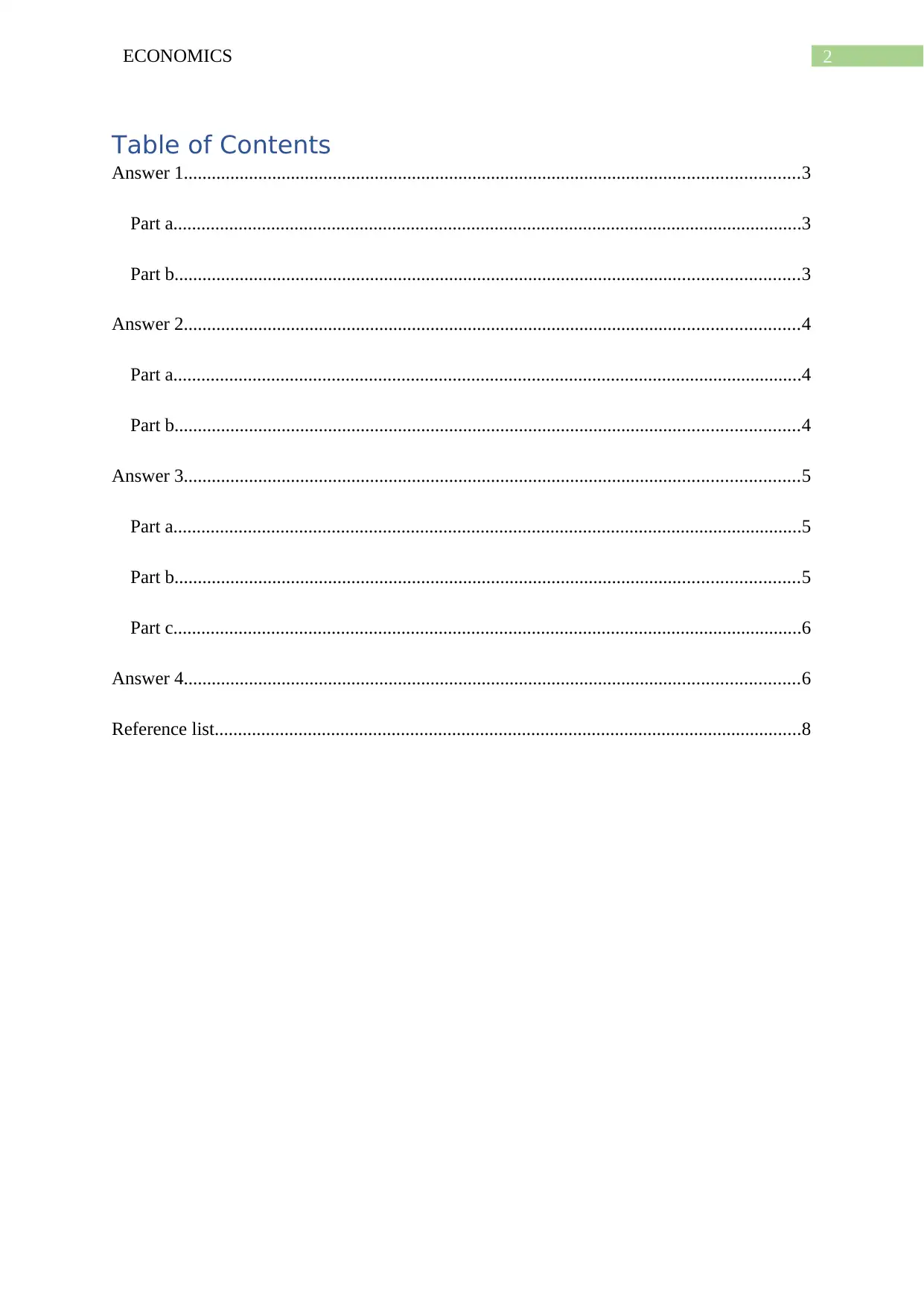
2ECONOMICS
Table of Contents
Answer 1....................................................................................................................................3
Part a.......................................................................................................................................3
Part b......................................................................................................................................3
Answer 2....................................................................................................................................4
Part a.......................................................................................................................................4
Part b......................................................................................................................................4
Answer 3....................................................................................................................................5
Part a.......................................................................................................................................5
Part b......................................................................................................................................5
Part c.......................................................................................................................................6
Answer 4....................................................................................................................................6
Reference list..............................................................................................................................8
Table of Contents
Answer 1....................................................................................................................................3
Part a.......................................................................................................................................3
Part b......................................................................................................................................3
Answer 2....................................................................................................................................4
Part a.......................................................................................................................................4
Part b......................................................................................................................................4
Answer 3....................................................................................................................................5
Part a.......................................................................................................................................5
Part b......................................................................................................................................5
Part c.......................................................................................................................................6
Answer 4....................................................................................................................................6
Reference list..............................................................................................................................8
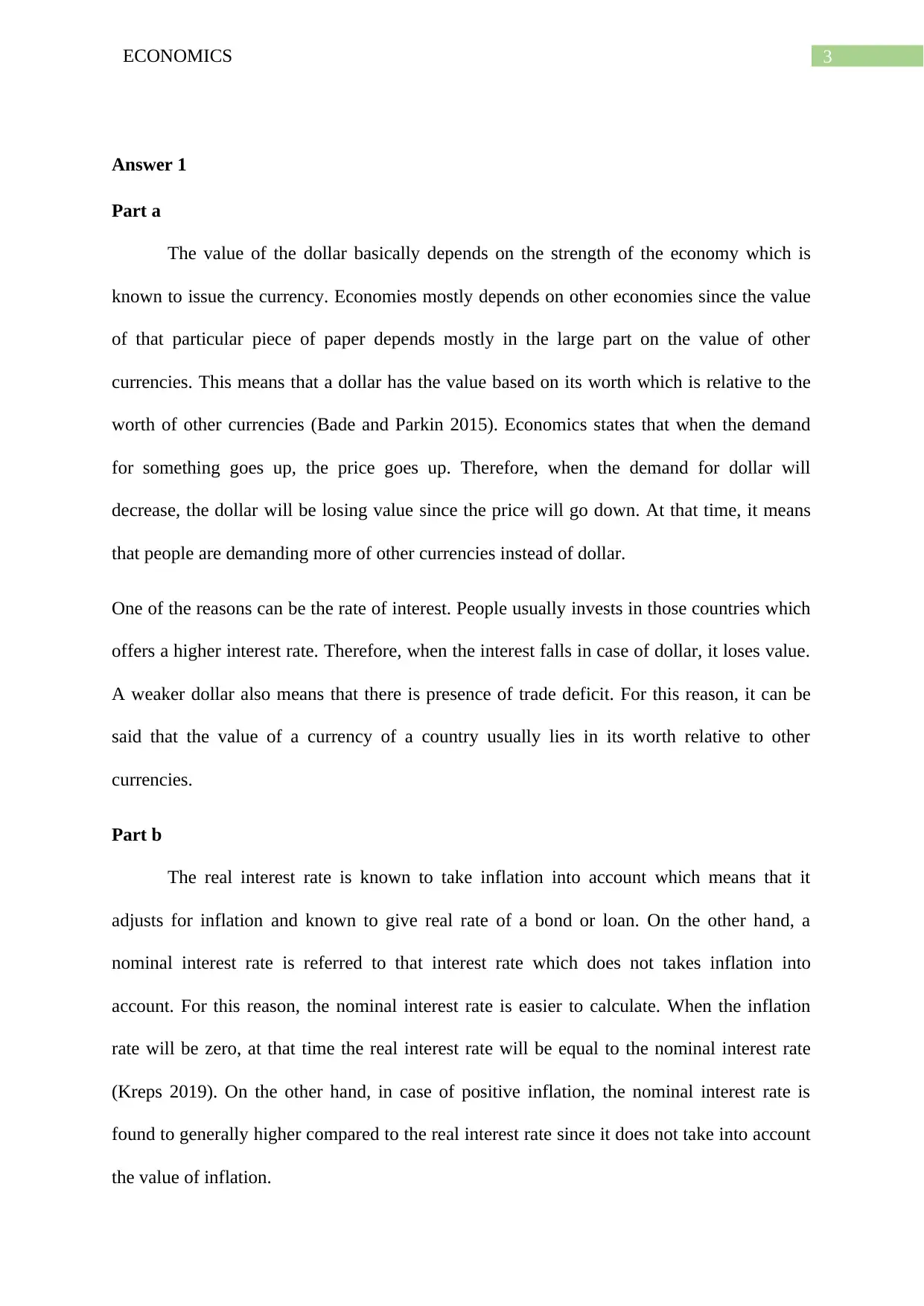
3ECONOMICS
Answer 1
Part a
The value of the dollar basically depends on the strength of the economy which is
known to issue the currency. Economies mostly depends on other economies since the value
of that particular piece of paper depends mostly in the large part on the value of other
currencies. This means that a dollar has the value based on its worth which is relative to the
worth of other currencies (Bade and Parkin 2015). Economics states that when the demand
for something goes up, the price goes up. Therefore, when the demand for dollar will
decrease, the dollar will be losing value since the price will go down. At that time, it means
that people are demanding more of other currencies instead of dollar.
One of the reasons can be the rate of interest. People usually invests in those countries which
offers a higher interest rate. Therefore, when the interest falls in case of dollar, it loses value.
A weaker dollar also means that there is presence of trade deficit. For this reason, it can be
said that the value of a currency of a country usually lies in its worth relative to other
currencies.
Part b
The real interest rate is known to take inflation into account which means that it
adjusts for inflation and known to give real rate of a bond or loan. On the other hand, a
nominal interest rate is referred to that interest rate which does not takes inflation into
account. For this reason, the nominal interest rate is easier to calculate. When the inflation
rate will be zero, at that time the real interest rate will be equal to the nominal interest rate
(Kreps 2019). On the other hand, in case of positive inflation, the nominal interest rate is
found to generally higher compared to the real interest rate since it does not take into account
the value of inflation.
Answer 1
Part a
The value of the dollar basically depends on the strength of the economy which is
known to issue the currency. Economies mostly depends on other economies since the value
of that particular piece of paper depends mostly in the large part on the value of other
currencies. This means that a dollar has the value based on its worth which is relative to the
worth of other currencies (Bade and Parkin 2015). Economics states that when the demand
for something goes up, the price goes up. Therefore, when the demand for dollar will
decrease, the dollar will be losing value since the price will go down. At that time, it means
that people are demanding more of other currencies instead of dollar.
One of the reasons can be the rate of interest. People usually invests in those countries which
offers a higher interest rate. Therefore, when the interest falls in case of dollar, it loses value.
A weaker dollar also means that there is presence of trade deficit. For this reason, it can be
said that the value of a currency of a country usually lies in its worth relative to other
currencies.
Part b
The real interest rate is known to take inflation into account which means that it
adjusts for inflation and known to give real rate of a bond or loan. On the other hand, a
nominal interest rate is referred to that interest rate which does not takes inflation into
account. For this reason, the nominal interest rate is easier to calculate. When the inflation
rate will be zero, at that time the real interest rate will be equal to the nominal interest rate
(Kreps 2019). On the other hand, in case of positive inflation, the nominal interest rate is
found to generally higher compared to the real interest rate since it does not take into account
the value of inflation.
⊘ This is a preview!⊘
Do you want full access?
Subscribe today to unlock all pages.

Trusted by 1+ million students worldwide
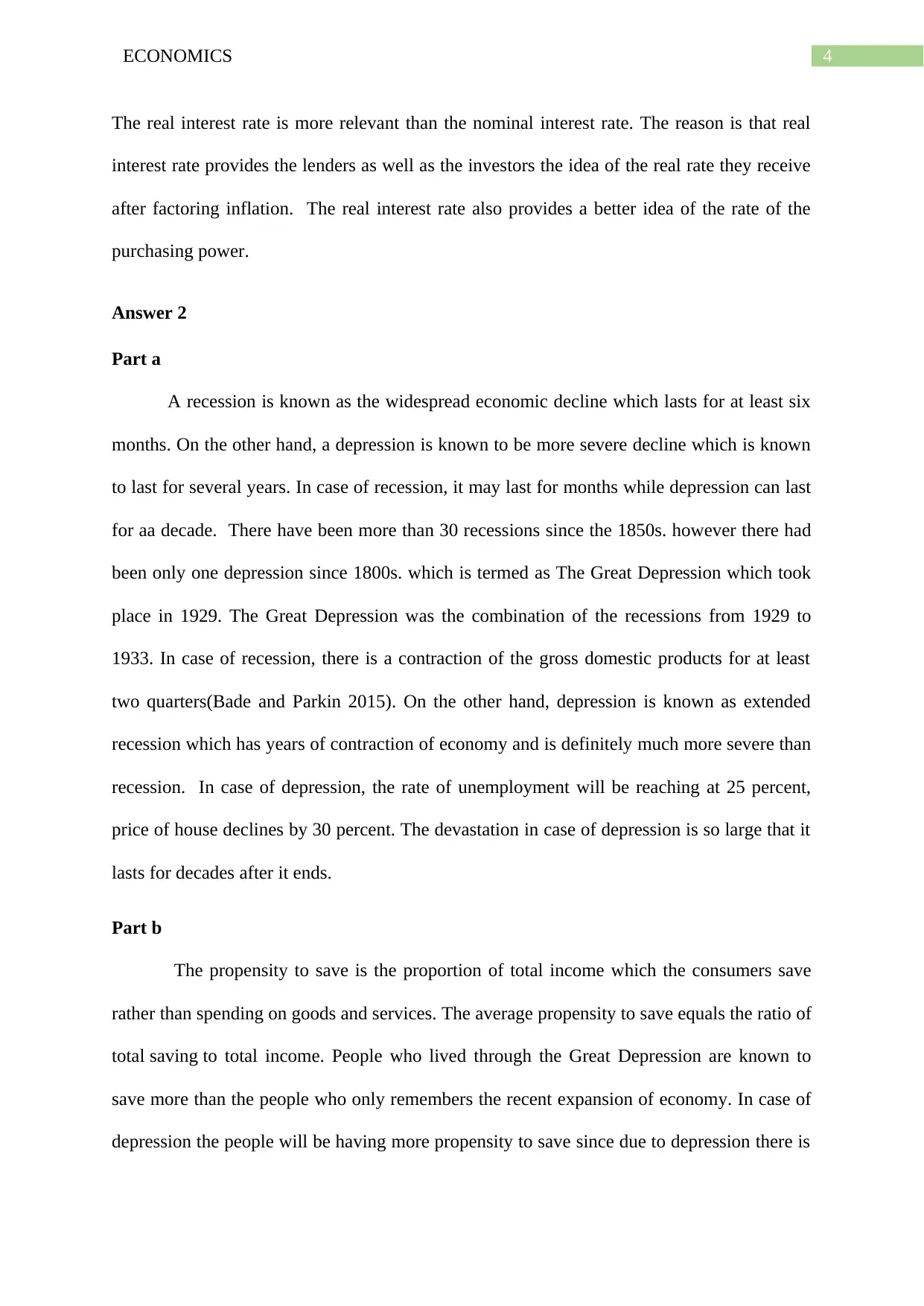
4ECONOMICS
The real interest rate is more relevant than the nominal interest rate. The reason is that real
interest rate provides the lenders as well as the investors the idea of the real rate they receive
after factoring inflation. The real interest rate also provides a better idea of the rate of the
purchasing power.
Answer 2
Part a
A recession is known as the widespread economic decline which lasts for at least six
months. On the other hand, a depression is known to be more severe decline which is known
to last for several years. In case of recession, it may last for months while depression can last
for aa decade. There have been more than 30 recessions since the 1850s. however there had
been only one depression since 1800s. which is termed as The Great Depression which took
place in 1929. The Great Depression was the combination of the recessions from 1929 to
1933. In case of recession, there is a contraction of the gross domestic products for at least
two quarters(Bade and Parkin 2015). On the other hand, depression is known as extended
recession which has years of contraction of economy and is definitely much more severe than
recession. In case of depression, the rate of unemployment will be reaching at 25 percent,
price of house declines by 30 percent. The devastation in case of depression is so large that it
lasts for decades after it ends.
Part b
The propensity to save is the proportion of total income which the consumers save
rather than spending on goods and services. The average propensity to save equals the ratio of
total saving to total income. People who lived through the Great Depression are known to
save more than the people who only remembers the recent expansion of economy. In case of
depression the people will be having more propensity to save since due to depression there is
The real interest rate is more relevant than the nominal interest rate. The reason is that real
interest rate provides the lenders as well as the investors the idea of the real rate they receive
after factoring inflation. The real interest rate also provides a better idea of the rate of the
purchasing power.
Answer 2
Part a
A recession is known as the widespread economic decline which lasts for at least six
months. On the other hand, a depression is known to be more severe decline which is known
to last for several years. In case of recession, it may last for months while depression can last
for aa decade. There have been more than 30 recessions since the 1850s. however there had
been only one depression since 1800s. which is termed as The Great Depression which took
place in 1929. The Great Depression was the combination of the recessions from 1929 to
1933. In case of recession, there is a contraction of the gross domestic products for at least
two quarters(Bade and Parkin 2015). On the other hand, depression is known as extended
recession which has years of contraction of economy and is definitely much more severe than
recession. In case of depression, the rate of unemployment will be reaching at 25 percent,
price of house declines by 30 percent. The devastation in case of depression is so large that it
lasts for decades after it ends.
Part b
The propensity to save is the proportion of total income which the consumers save
rather than spending on goods and services. The average propensity to save equals the ratio of
total saving to total income. People who lived through the Great Depression are known to
save more than the people who only remembers the recent expansion of economy. In case of
depression the people will be having more propensity to save since due to depression there is
Paraphrase This Document
Need a fresh take? Get an instant paraphrase of this document with our AI Paraphraser
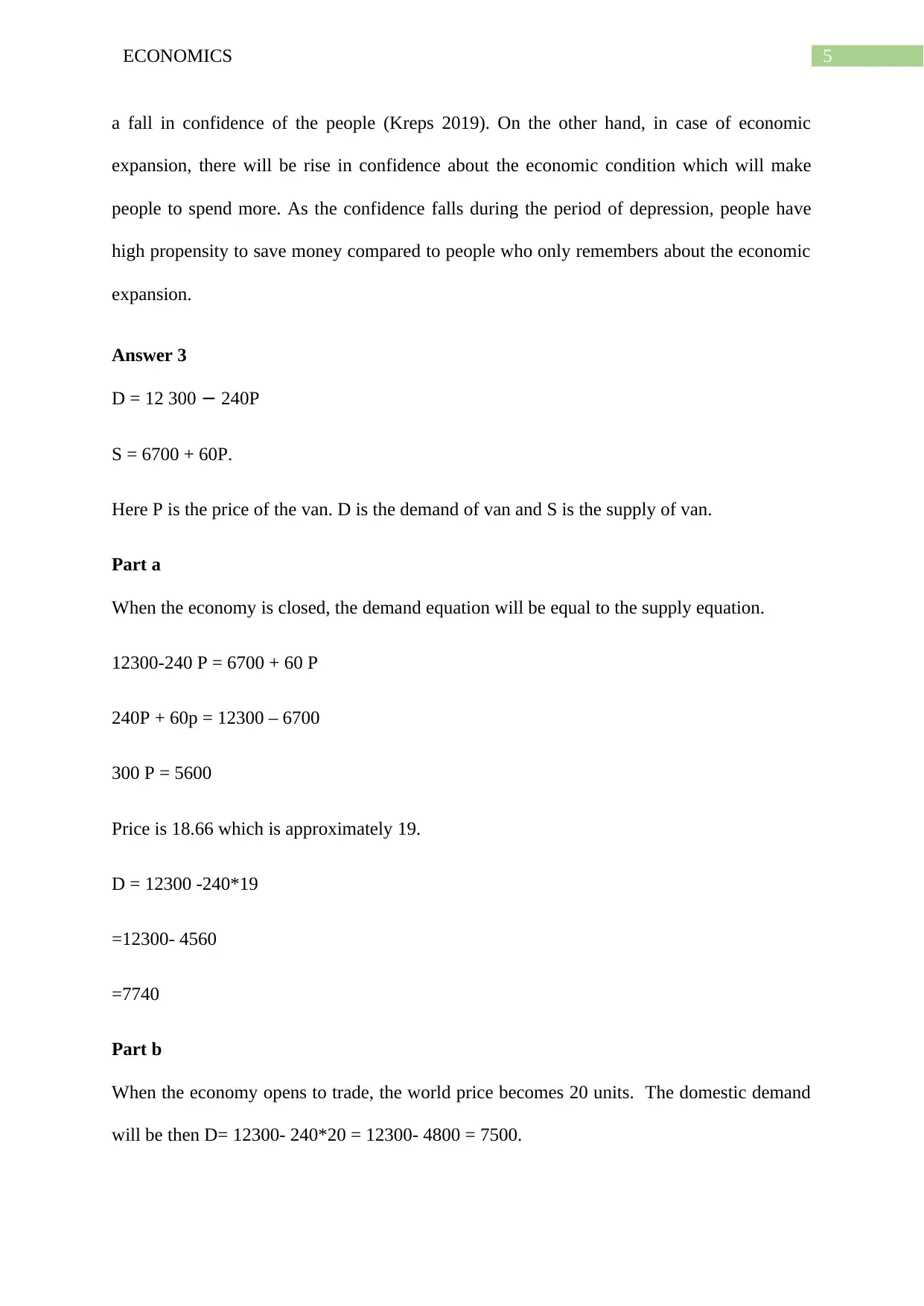
5ECONOMICS
a fall in confidence of the people (Kreps 2019). On the other hand, in case of economic
expansion, there will be rise in confidence about the economic condition which will make
people to spend more. As the confidence falls during the period of depression, people have
high propensity to save money compared to people who only remembers about the economic
expansion.
Answer 3
D = 12 300 − 240P
S = 6700 + 60P.
Here P is the price of the van. D is the demand of van and S is the supply of van.
Part a
When the economy is closed, the demand equation will be equal to the supply equation.
12300-240 P = 6700 + 60 P
240P + 60p = 12300 – 6700
300 P = 5600
Price is 18.66 which is approximately 19.
D = 12300 -240*19
=12300- 4560
=7740
Part b
When the economy opens to trade, the world price becomes 20 units. The domestic demand
will be then D= 12300- 240*20 = 12300- 4800 = 7500.
a fall in confidence of the people (Kreps 2019). On the other hand, in case of economic
expansion, there will be rise in confidence about the economic condition which will make
people to spend more. As the confidence falls during the period of depression, people have
high propensity to save money compared to people who only remembers about the economic
expansion.
Answer 3
D = 12 300 − 240P
S = 6700 + 60P.
Here P is the price of the van. D is the demand of van and S is the supply of van.
Part a
When the economy is closed, the demand equation will be equal to the supply equation.
12300-240 P = 6700 + 60 P
240P + 60p = 12300 – 6700
300 P = 5600
Price is 18.66 which is approximately 19.
D = 12300 -240*19
=12300- 4560
=7740
Part b
When the economy opens to trade, the world price becomes 20 units. The domestic demand
will be then D= 12300- 240*20 = 12300- 4800 = 7500.
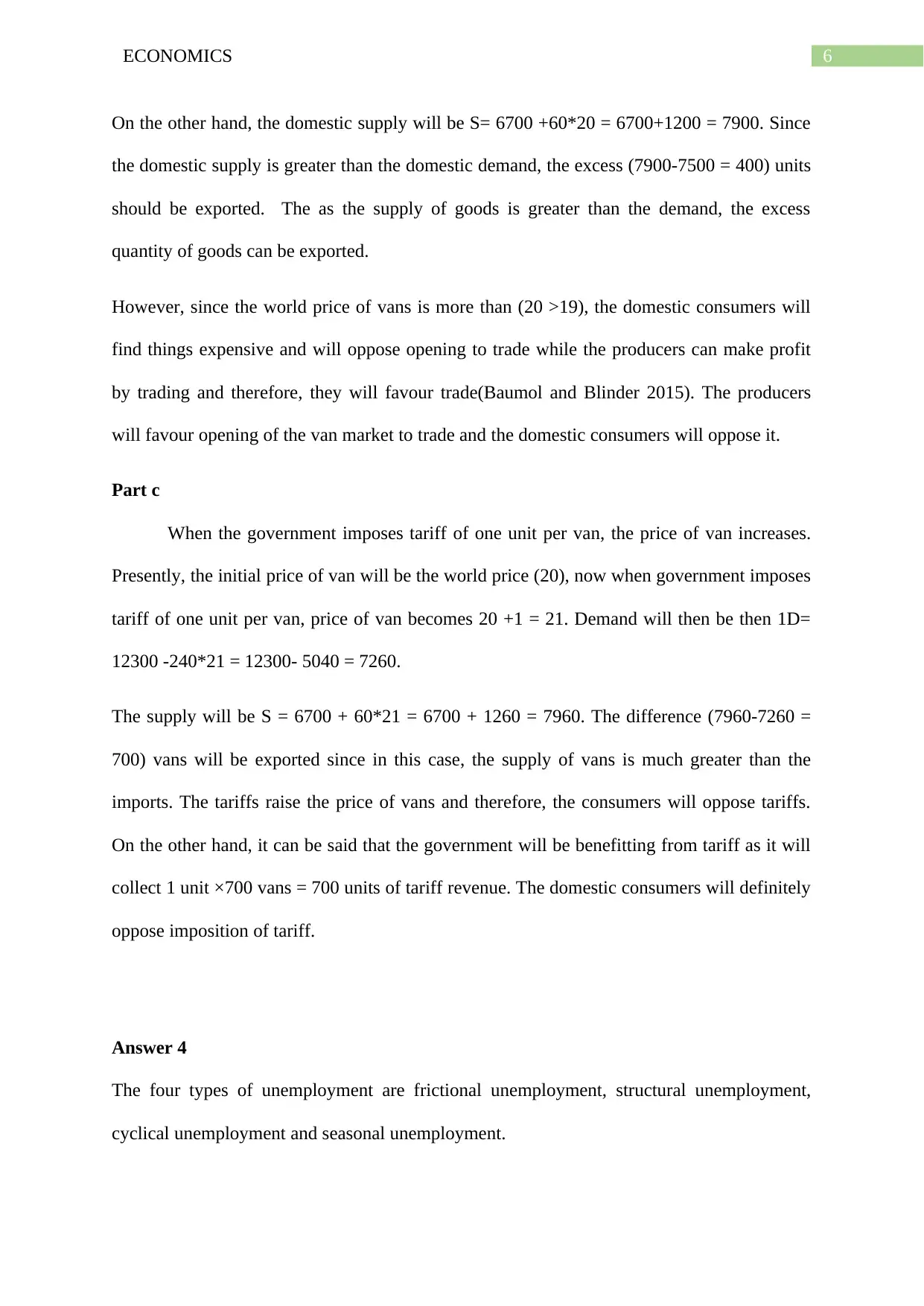
6ECONOMICS
On the other hand, the domestic supply will be S= 6700 +60*20 = 6700+1200 = 7900. Since
the domestic supply is greater than the domestic demand, the excess (7900-7500 = 400) units
should be exported. The as the supply of goods is greater than the demand, the excess
quantity of goods can be exported.
However, since the world price of vans is more than (20 >19), the domestic consumers will
find things expensive and will oppose opening to trade while the producers can make profit
by trading and therefore, they will favour trade(Baumol and Blinder 2015). The producers
will favour opening of the van market to trade and the domestic consumers will oppose it.
Part c
When the government imposes tariff of one unit per van, the price of van increases.
Presently, the initial price of van will be the world price (20), now when government imposes
tariff of one unit per van, price of van becomes 20 +1 = 21. Demand will then be then 1D=
12300 -240*21 = 12300- 5040 = 7260.
The supply will be S = 6700 + 60*21 = 6700 + 1260 = 7960. The difference (7960-7260 =
700) vans will be exported since in this case, the supply of vans is much greater than the
imports. The tariffs raise the price of vans and therefore, the consumers will oppose tariffs.
On the other hand, it can be said that the government will be benefitting from tariff as it will
collect 1 unit ×700 vans = 700 units of tariff revenue. The domestic consumers will definitely
oppose imposition of tariff.
Answer 4
The four types of unemployment are frictional unemployment, structural unemployment,
cyclical unemployment and seasonal unemployment.
On the other hand, the domestic supply will be S= 6700 +60*20 = 6700+1200 = 7900. Since
the domestic supply is greater than the domestic demand, the excess (7900-7500 = 400) units
should be exported. The as the supply of goods is greater than the demand, the excess
quantity of goods can be exported.
However, since the world price of vans is more than (20 >19), the domestic consumers will
find things expensive and will oppose opening to trade while the producers can make profit
by trading and therefore, they will favour trade(Baumol and Blinder 2015). The producers
will favour opening of the van market to trade and the domestic consumers will oppose it.
Part c
When the government imposes tariff of one unit per van, the price of van increases.
Presently, the initial price of van will be the world price (20), now when government imposes
tariff of one unit per van, price of van becomes 20 +1 = 21. Demand will then be then 1D=
12300 -240*21 = 12300- 5040 = 7260.
The supply will be S = 6700 + 60*21 = 6700 + 1260 = 7960. The difference (7960-7260 =
700) vans will be exported since in this case, the supply of vans is much greater than the
imports. The tariffs raise the price of vans and therefore, the consumers will oppose tariffs.
On the other hand, it can be said that the government will be benefitting from tariff as it will
collect 1 unit ×700 vans = 700 units of tariff revenue. The domestic consumers will definitely
oppose imposition of tariff.
Answer 4
The four types of unemployment are frictional unemployment, structural unemployment,
cyclical unemployment and seasonal unemployment.
⊘ This is a preview!⊘
Do you want full access?
Subscribe today to unlock all pages.

Trusted by 1+ million students worldwide
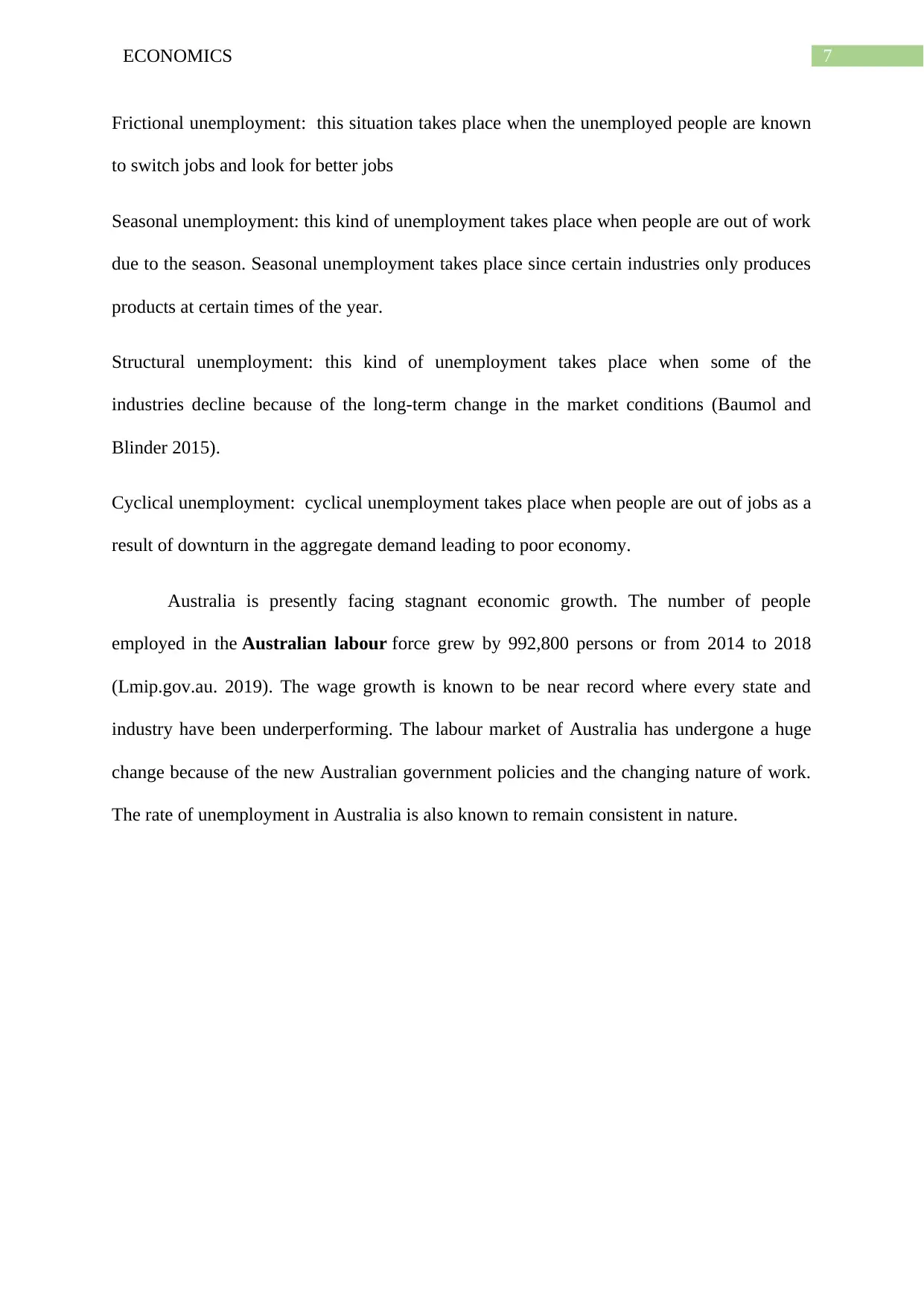
7ECONOMICS
Frictional unemployment: this situation takes place when the unemployed people are known
to switch jobs and look for better jobs
Seasonal unemployment: this kind of unemployment takes place when people are out of work
due to the season. Seasonal unemployment takes place since certain industries only produces
products at certain times of the year.
Structural unemployment: this kind of unemployment takes place when some of the
industries decline because of the long-term change in the market conditions (Baumol and
Blinder 2015).
Cyclical unemployment: cyclical unemployment takes place when people are out of jobs as a
result of downturn in the aggregate demand leading to poor economy.
Australia is presently facing stagnant economic growth. The number of people
employed in the Australian labour force grew by 992,800 persons or from 2014 to 2018
(Lmip.gov.au. 2019). The wage growth is known to be near record where every state and
industry have been underperforming. The labour market of Australia has undergone a huge
change because of the new Australian government policies and the changing nature of work.
The rate of unemployment in Australia is also known to remain consistent in nature.
Frictional unemployment: this situation takes place when the unemployed people are known
to switch jobs and look for better jobs
Seasonal unemployment: this kind of unemployment takes place when people are out of work
due to the season. Seasonal unemployment takes place since certain industries only produces
products at certain times of the year.
Structural unemployment: this kind of unemployment takes place when some of the
industries decline because of the long-term change in the market conditions (Baumol and
Blinder 2015).
Cyclical unemployment: cyclical unemployment takes place when people are out of jobs as a
result of downturn in the aggregate demand leading to poor economy.
Australia is presently facing stagnant economic growth. The number of people
employed in the Australian labour force grew by 992,800 persons or from 2014 to 2018
(Lmip.gov.au. 2019). The wage growth is known to be near record where every state and
industry have been underperforming. The labour market of Australia has undergone a huge
change because of the new Australian government policies and the changing nature of work.
The rate of unemployment in Australia is also known to remain consistent in nature.
Paraphrase This Document
Need a fresh take? Get an instant paraphrase of this document with our AI Paraphraser
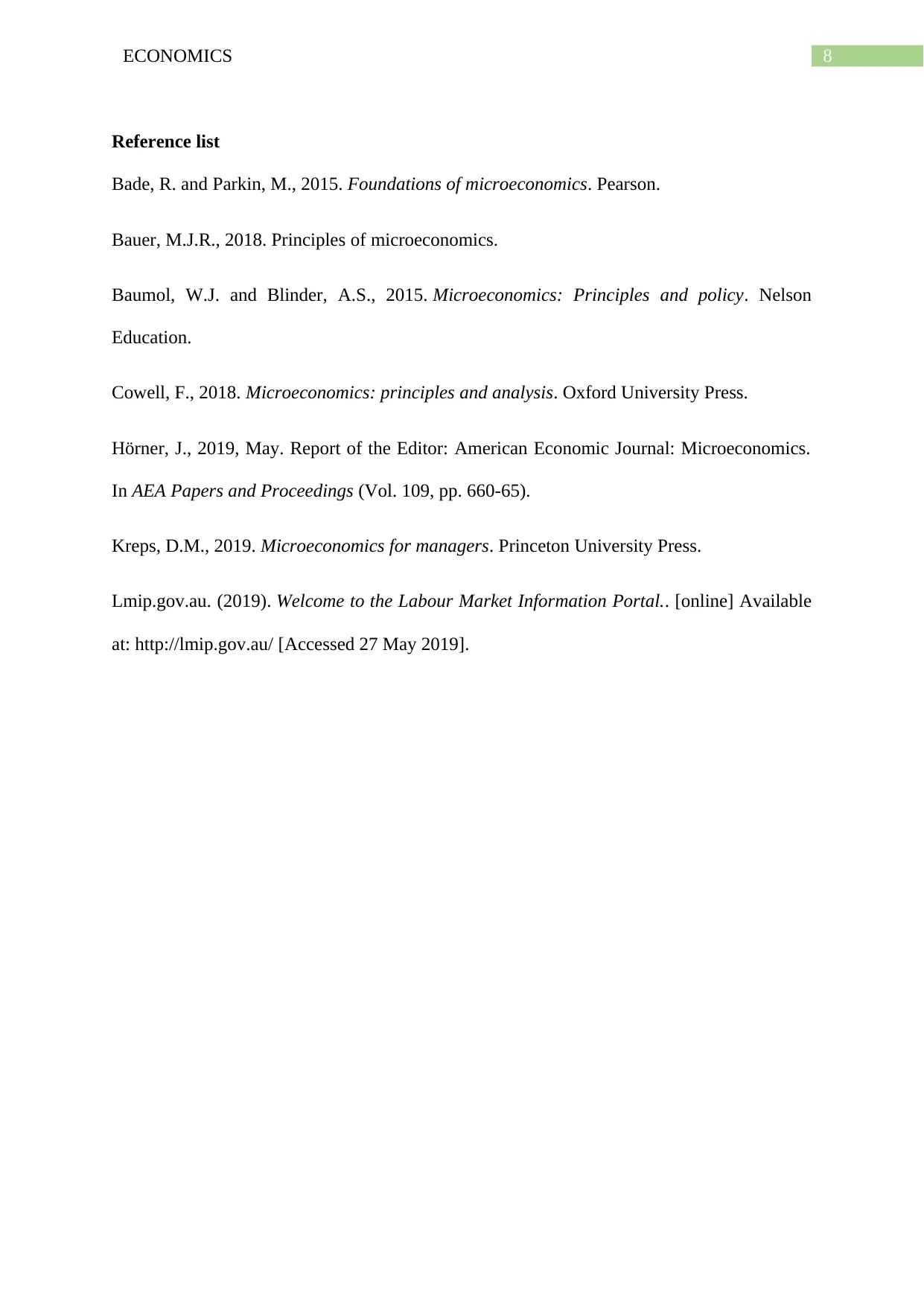
8ECONOMICS
Reference list
Bade, R. and Parkin, M., 2015. Foundations of microeconomics. Pearson.
Bauer, M.J.R., 2018. Principles of microeconomics.
Baumol, W.J. and Blinder, A.S., 2015. Microeconomics: Principles and policy. Nelson
Education.
Cowell, F., 2018. Microeconomics: principles and analysis. Oxford University Press.
Hörner, J., 2019, May. Report of the Editor: American Economic Journal: Microeconomics.
In AEA Papers and Proceedings (Vol. 109, pp. 660-65).
Kreps, D.M., 2019. Microeconomics for managers. Princeton University Press.
Lmip.gov.au. (2019). Welcome to the Labour Market Information Portal.. [online] Available
at: http://lmip.gov.au/ [Accessed 27 May 2019].
Reference list
Bade, R. and Parkin, M., 2015. Foundations of microeconomics. Pearson.
Bauer, M.J.R., 2018. Principles of microeconomics.
Baumol, W.J. and Blinder, A.S., 2015. Microeconomics: Principles and policy. Nelson
Education.
Cowell, F., 2018. Microeconomics: principles and analysis. Oxford University Press.
Hörner, J., 2019, May. Report of the Editor: American Economic Journal: Microeconomics.
In AEA Papers and Proceedings (Vol. 109, pp. 660-65).
Kreps, D.M., 2019. Microeconomics for managers. Princeton University Press.
Lmip.gov.au. (2019). Welcome to the Labour Market Information Portal.. [online] Available
at: http://lmip.gov.au/ [Accessed 27 May 2019].
1 out of 8
Related Documents
Your All-in-One AI-Powered Toolkit for Academic Success.
+13062052269
info@desklib.com
Available 24*7 on WhatsApp / Email
![[object Object]](/_next/static/media/star-bottom.7253800d.svg)
Unlock your academic potential
Copyright © 2020–2025 A2Z Services. All Rights Reserved. Developed and managed by ZUCOL.




